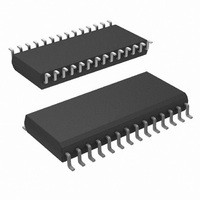COP8SGR728M7/NOPB National Semiconductor, COP8SGR728M7/NOPB Datasheet - Page 48

COP8SGR728M7/NOPB
Manufacturer Part Number
COP8SGR728M7/NOPB
Description
MCU 8BIT CMOS ROM OTP 28-SOIC
Manufacturer
National Semiconductor
Series
COP8™ 8SGr
Datasheet
1.COP8SGE728N8NOPB.pdf
(62 pages)
Specifications of COP8SGR728M7/NOPB
Core Processor
COP8
Core Size
8-Bit
Speed
15MHz
Connectivity
Microwire/Plus (SPI), UART/USART
Peripherals
POR, PWM, WDT
Number Of I /o
24
Program Memory Size
32KB (32K x 8)
Program Memory Type
OTP
Ram Size
512 x 8
Voltage - Supply (vcc/vdd)
2.7 V ~ 5.5 V
Oscillator Type
Internal
Operating Temperature
-40°C ~ 125°C
Package / Case
28-SOIC
Data Bus Width
8 bit
Maximum Clock Frequency
15 MHz
Data Ram Size
512 B
Number Of Programmable I/os
40
Number Of Timers
3
Height
2.34 mm
Interface Type
USART
Length
17.91 mm
Maximum Operating Temperature
+ 125 C
Minimum Operating Temperature
- 40 C
Supply Voltage (max)
5.5 V
Supply Voltage (min)
2.7 V
Width
7.49 mm
For Use With
COP8SG-EPU - BOARD PROTOTYPE/TARGET COP8
Lead Free Status / RoHS Status
Lead free / RoHS Compliant
Eeprom Size
-
Data Converters
-
Lead Free Status / Rohs Status
Details
Other names
COP8SGR728M7
www.national.com
14.0 Instruction Set
Example: Load Accumulator Immediate
Immediate Short. This is a special case of an immediate
instruction. In the “Load B immediate” instruction, the 4-bit
immediate value in the instruction is loaded into the lower
nibble of the B register. The upper nibble of the B register is
reset to 0000 binary.
Example: Load B Register Immediate Short
Indirect from Program Memory. This is a special case of
an indirect instruction that allows access to data tables
stored in program memory. In the “Load Accumulator Indi-
rect” (LAID) instruction, the upper and lower bytes of the
Program Counter (PCU and PCL) are used temporarily as a
pointer to program memory. For purposes of accessing pro-
gram memory, the contents of the Accumulator and PCL are
exchanged. The data pointed to by the Program Counter is
loaded into the Accumulator, and simultaneously, the original
contents of PCL are restored so that the program can re-
sume normal execution.
Example: Load Accumulator Indirect
14.3.2 Tranfer-of-Control Addressing Modes
Program instructions are usually executed in sequential or-
der. However, Jump instructions can be used to change the
normal execution sequence. Several transfer-of-control ad-
dressing modes are available to specify jump addresses.
A change in program flow requires a non-incremental
change in the Program Counter contents. The Program
Counter consists of two bytes, designated the upper byte
(PCU) and lower byte (PCL). The most significant bit of PCU
is not used, leaving 15 bits to address the program memory.
Different addressing modes are used to specify the new
address for the Program Counter. The choice of addressing
mode depends primarily on the distance of the jump. Farther
jumps sometimes require more instruction bytes in order to
completely specify the new Program Counter contents.
The available transfer-of-control addressing modes are:
• Jump Relative
• Jump Absolute
• Jump Absolute Long
Memory Location
Accumulator
Accumulator
LD A, # 05
LD B, # 7
LAID
Reg/Data
Reg/Data
Reg/Data
041F Hex
B Pointer
Memory
Memory
Memory
PCU
PCL
Contents
Contents
Before
12 Hex
XX Hex
Before
Contents
04 Hex
35 Hex
1F Hex
25 Hex
Before
(Continued)
Contents
Contents
07 Hex
05 Hex
After
Contents
After
04 Hex
36 Hex
25 Hex
25 Hex
After
48
• Jump Indirect
The transfer-of-control addressing modes are described be-
low. Each description includes an example of a Jump in-
struction using a particular addressing mode, and the effect
on the Program Counter bytes of executing that instruction.
Jump Relative. In this 1-byte instruction, six bits of the
instruction opcode specify the distance of the jump from the
current program memory location. The distance of the jump
can range from −31 to +32. A JP+1 instruction is not allowed.
The programmer should use a NOP instead.
Example: Jump Relative
Jump Absolute. In this 2-byte instruction, 12 bits of the
instruction opcode specify the new contents of the Program
Counter. The upper three bits of the Program Counter re-
main unchanged, restricting the new Program Counter ad-
dress to the same 4 kbyte address space as the current
instruction.
(This restriction is relevant only in devices using more than
one 4 kbyte program memory space.)
Example: Jump Absolute
Jump Absolute Long. In this 3-byte instruction, 15 bits of
the instruction opcode specify the new contents of the Pro-
gram Counter.
Example: Jump Absolute Long
Jump Indirect. In this 1-byte instruction, the lower byte of
the jump address is obtained from a table stored in program
memory, with the Accumulator serving as the low order byte
of a pointer into program memory. For purposes of access-
ing program memory, the contents of the Accumulator are
written to PCL (temporarily). The data pointed to by the
Program Counter (PCH/PCL) is loaded into PCL, while PCH
remains unchanged.
Example: Jump Indirect
Accumulator
JP 0A
JMP 0125
JMP 03625
JID
Memory
Memory
Memory
PCU
PCU
Reg/
PCU
Reg/
PCU
PCL
PCL
PCL
PCL
Reg
Reg
Contents
Contents
Contents
0C Hex
02 Hex
05 Hex
77 Hex
Before
Before
Before
42 Hex
36 Hex
Contents
C4 Hex
01 Hex
26 Hex
Before
Contents
Contents
Contents
02 Hex
0F Hex
01 Hex
25 Hex
36 Hex
25 Hex
After
After
Contents
After
01 Hex
32 Hex
26 Hex
After










